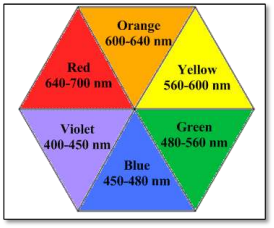
Concept explainers
(a)
Interpretation:
The type of the light source needed for the spectrometer needs to be determined.
Concept introduction:
The observed light is always complementary to the color of the light absorbed by it.
Explanation of Solution
To determine the concentration of solution using spectrometer, the source of light are generally Tungsten filament with wavelength range 300-2500 nm, xenon arc lamb with wavelength range 160-2000 nm, deuterium arc lamp with wavelength range 190-400 nm and light emitting diodes for visible wavelengths (360-950 nm).
Since, the given solution is red color with wavelength range 640-700 nm.

The observed light is always complementary to the color of the light absorbed by it. From the color wheel, the color of light complementary to red is green. Thus, red solution absorbs in the wavelength range of 480-560 nm. The wavelength of red light that is 640-700 nm is transmitted by the red solution.
Thus, the solution absorbs the wavelength range of 480-560 nm (green light) and the light source used can be tungsten filament with range 300-2500 nm. Light emitting diodes can also be used with wavelength range 360-950 nm.
(b)
Interpretation:
The placement of light source, the detector and the sample needs to be sketched. The path of the light should be shown in the drawing.
Concept introduction:
A spectrometer is used to determine the amount of light a sample can absorb.
Explanation of Solution
In the spectrometer, the main components are light source, detector and sample.
The light from the source first falls on the sample solution and detector is placed after the sample to obtain the results.
The sketch can be drawn as follows:

(c)
Interpretation:
The observation for the two different solutions needs to be predicted.
Concept introduction:
A spectrometer is used to determine the amount of light a sample can absorb.
Explanation of Solution
If the two solutions are different, the
The intensity of light absorbed by two different solutions will be different. Also, depending on the range of the wavelength of transmitted light different detectors are used.
(d)
Interpretation:
Whether a UV-sensitive paper can be used for the detector or not needs to be explained.
Concept introduction:
In the spectrometer, detector is used show the presence or absence of spectrum which is extracted for different type of elements present in the sample. The intensity of the spectrum is also measured by detector.
Explanation of Solution
The wavelength range for UV light is 100-400 nm since, the wavelength of red light which is transmitted by the solution is 640-700 nm which is not in UV range thus, UV sensitive paper cannot be used for the detector. Due to difference in wavelength range, UV sensitive paper cannot detect the light transmitted by red color solution.
Chapter U5 Solutions
Living by Chemistry
Additional Science Textbook Solutions
Essential Organic Chemistry (3rd Edition)
Chemistry: The Central Science (13th Edition)
Chemistry For Changing Times (14th Edition)
Chemistry: Matter and Change
General, Organic, and Biological Chemistry (3rd Edition)
Chemistry: An Introduction to General, Organic, and Biological Chemistry (13th Edition)
 ChemistryChemistryISBN:9781305957404Author:Steven S. Zumdahl, Susan A. Zumdahl, Donald J. DeCostePublisher:Cengage Learning
ChemistryChemistryISBN:9781305957404Author:Steven S. Zumdahl, Susan A. Zumdahl, Donald J. DeCostePublisher:Cengage Learning ChemistryChemistryISBN:9781259911156Author:Raymond Chang Dr., Jason Overby ProfessorPublisher:McGraw-Hill Education
ChemistryChemistryISBN:9781259911156Author:Raymond Chang Dr., Jason Overby ProfessorPublisher:McGraw-Hill Education Principles of Instrumental AnalysisChemistryISBN:9781305577213Author:Douglas A. Skoog, F. James Holler, Stanley R. CrouchPublisher:Cengage Learning
Principles of Instrumental AnalysisChemistryISBN:9781305577213Author:Douglas A. Skoog, F. James Holler, Stanley R. CrouchPublisher:Cengage Learning Organic ChemistryChemistryISBN:9780078021558Author:Janice Gorzynski Smith Dr.Publisher:McGraw-Hill Education
Organic ChemistryChemistryISBN:9780078021558Author:Janice Gorzynski Smith Dr.Publisher:McGraw-Hill Education Chemistry: Principles and ReactionsChemistryISBN:9781305079373Author:William L. Masterton, Cecile N. HurleyPublisher:Cengage Learning
Chemistry: Principles and ReactionsChemistryISBN:9781305079373Author:William L. Masterton, Cecile N. HurleyPublisher:Cengage Learning Elementary Principles of Chemical Processes, Bind...ChemistryISBN:9781118431221Author:Richard M. Felder, Ronald W. Rousseau, Lisa G. BullardPublisher:WILEY
Elementary Principles of Chemical Processes, Bind...ChemistryISBN:9781118431221Author:Richard M. Felder, Ronald W. Rousseau, Lisa G. BullardPublisher:WILEY





